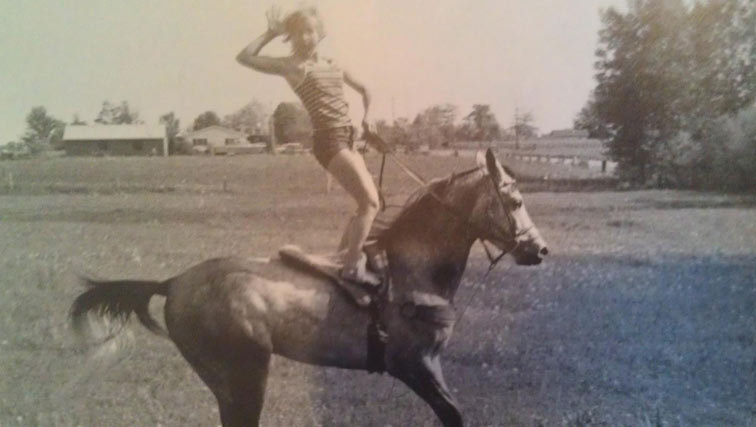Julie Krone: A Jockey's Inspiration

Julie Krone rides bareback in her youth (Photos courtesy of Julie Krone)
My memory has stored and arranged many big and small events in my life. Some of the little details seem irrelevant except for the fact that my mind has indeed hung onto them, making them important in their own right, however small they might be. Big things and public experiences are obvious with the most important being something like winning the Belmont Stakes or a Breeders’ Cup. But it’s the smaller and seemingly more irrelevant things that in the end make the difference.
What is it that gives importance to some of these things? A moment so small it can take years to reveal itself. It’s December in Michigan, in the late 1970’s, and a 16-year-old girl is stuck at home with a case of the mumps. Later in the week she finally is allowed to go out for some fresh air with her dad, and she finds herself standing in front of a one dollar book bin at a local book store when something catches her eye. It was not the first time a picture of a racehorse or jockey would cause a butterfly feeling in my gut, and definitely not the last. But on the cover of this book there was the picture of a boy, close to my age, with roses on his lap staring back at me from horseback.
Julie Krone with her pony as a child
My dad gave me the dollar I needed, and at that moment the book became my window to the world of the racetrack. To this day a little spark lights my heart when I put my hand on the dog-eared paperback, the pages are now yellowed, written by Pete Axthelm. It is called “The Kid,” and it is the story of Steve Cauthen.
As far as I am concerned, “The Kid” should be a required reading (followed by a test) for anyone who has a desire to ever be a jockey. In that book I learned a jockey must have strength and a keen sense of timing. A jockey must have cat-like reflexes and an ability to communicate with horses. When I read the words, “Steve’s touch with a horse was a matter of instinct, his knowledge of entire races was a more cerebral affair,” I said to myself yes, this is the language I know.
My mother taught me the essential subtleties of communicating with a horse. She could do things with horses people only dreamed of. But when that jockey flame ignited, all I wanted was to copy everything Cauthen did. I “rode” hay bales obsessed with my form, learning to switch sticks. My rides through the Michigan apple orchards in the fall changed. Instead of riding bareback and swatting deer flies while munching apples, I counted trees and pretended they were furlongs. I shortened my stirrups and made my dad take photos so I could examine my style.
But except for my mom and dad, everybody told me that a girl could not be a jockey, any more than a pig could fly. To that point I had felt genderless, with a desire to learn a trade. It was as if they were saying I’d lost all chance to be a jockey from the moment I was born a girl. Then I found another book, called “The Lady Is a Jock,” by Lynn Haney.
The women in the book were as different as night and day. Kathy Kusner, Patty Barton, Barbara Jo Rubin, Diane Crump, Robyn Smith – they all faced in their own way exactly what I was hearing: “You can’t.” I was not discouraged. Instead, I was inspired. These women were no different from Steve Cauthen, my ideal as a jockey – woman or man. In “The Kid,” Pete Axthelm quoted the German equestrian Wilhelm Museler: “Anybody can learn to ride, for riding is nothing but a skill. But it can be made into an art. And who would not want to be an artist?”
Loyalty to that art form is genderless, just like the gifts and talents to communicate with a racehorse. So I stepped away from cultural stereotypes into my own world and started to work on becoming that artist.
